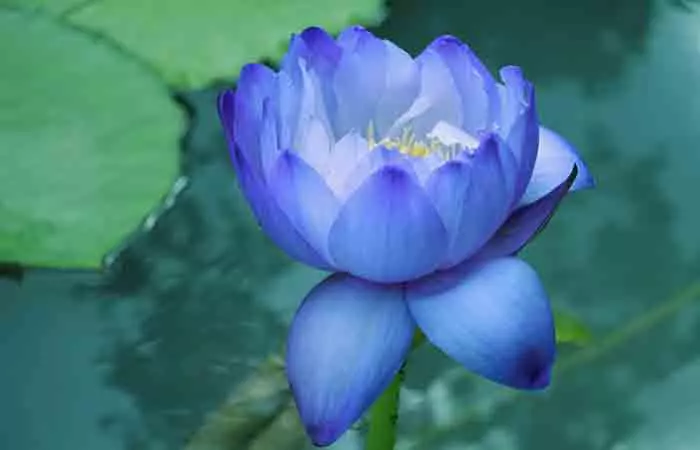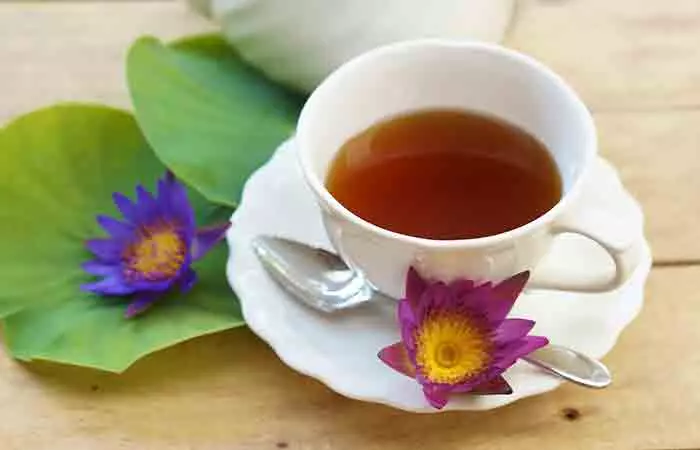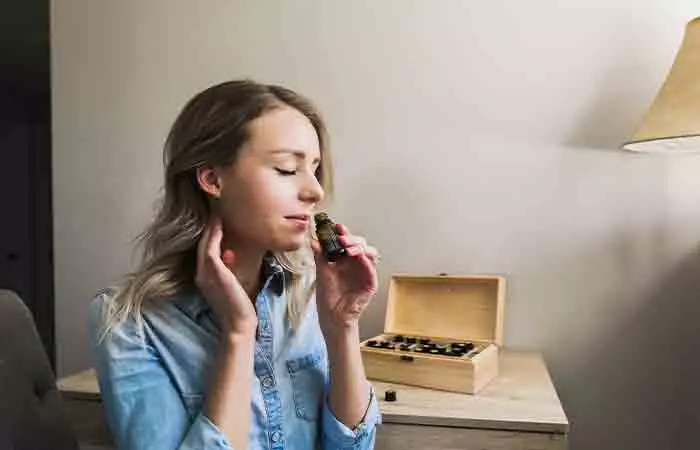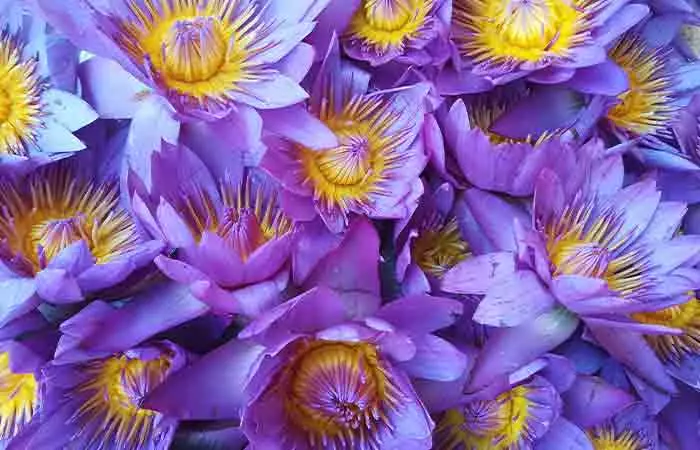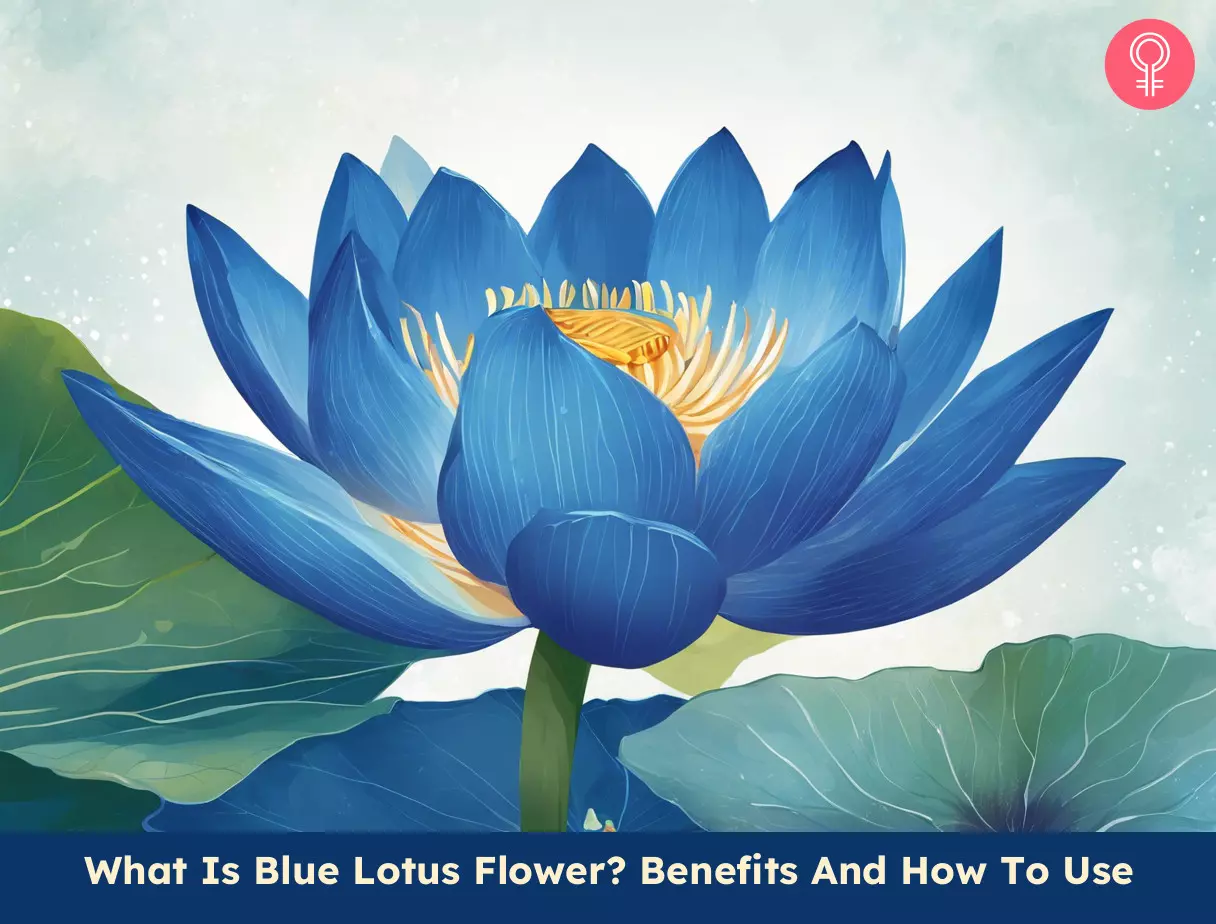Who Can Consume It? Those dealing with sleep disorders, anxiety, aging-related issues, and irregular menstrual cycles can use this flower. How Often? There is no general accepted dosage, but 0.17 oz. (5 grams) per person in 250-500 mL of lotus water is accepted. Caution High doses can cause issues like altered mental state, anxiety, chest pain, brief periods of oxygen limitation, and hallucinations.
The blue lotus flower is traditionally used as a sleep aid, detoxifying agent, and aphrodisiac. It is rich in antioxidants and widely used in Ayurveda for relieving diarrhea, fevers, urinary problems, and heart palpitations (1). Ancient Egyptians and Mayans used blue lotus flowers as ritual plants to achieve euphoria and ecstasy. The flower was depicted in ancient Egyptian papyri and tomb art, and during the 14th century B.C., ancient Egyptians used it for healing and shamanic rituals. These plants played a vital role in the cultures they flourished in (2). Licensed wellness professional and medicinal cannabis educator Jade Sancho-Duser shares, “Egyptians used to decant blue lotus in wine along with other flowers and herbs (e.g., poppies). This would produce euphoric effects, which have been said to have a similar effect as MDMA (Ecstasy/Molly). The Ancient Egyptians would serve this wine and engage in large celebrations.” Today, the blue lotus flower is used to soothe anxiety and help people sleep better. Some have also described it as mildly stimulating. Jade adds, “Blue lotus can be hallucinogenic to some extent if consumed in mass quantities (which I have experienced firsthand), but in reality, it is mildly psychoactive. The potency of this plant is much more notable when mixed in an alcohol-based tincture as it begins to enhance the effects of the psychoactive properties.”
Potential Health Benefits Of Blue Lotus Flower
Pallini Winnifred, RDN, says, “Blue lotus tea is made by steeping the petals of the flower in hot water. Some people believe that consuming blue lotus tea can have a number of health benefits, such as reducing anxiety and stress, improving digestion, and promoting feelings of calm and relaxation.” She adds, “It is also said that blue lotus is an aphrodisiac and anesthetic and can be used to improve sexual function. However, there is also a lack of scientific evidence to support this claim.” She further states, “The effects of blue lotus on energy levels are not clear. Some people may feel more relaxed or calm after consuming it, which can have a positive impact on overall well-being and energy levels.” Here’s an insight into the beneficial blue lotus effects you should know about. Keep scrolling down!
1. A Potent Psychoactive
The blue lotus flower contains alkaloids, tannins, phenolic acids, and flavonoids. The alkaloids apomorphine and nuciferine in the plant help release dopamine and serotonin to influence your mood and produce mild psychoactive effects that induce euphoria (1), (3). Anecdotal evidence suggests that the flower may also cause visual and auditory hallucinations.
2. May Help You Sleep
The alkaloids nuciferine and apomorphine in the flower may induce sleep and help you wake up without hallucinations. Apomorphine is often used in clinical settings as anesthesia and to ease sleep problems associated with Parkinson’s disease. Nuciferine enhances the sleep-inducing effects of apomorphine (4), (5), (6). According to anecdotal evidence, brewing blue lotus flower tea helped people have more lucid dreams.
3. May Relieve Anxiety
Blue lotus flowers are known for their anxiety-relieving abilities. Lotus blossoms are used to ‘calm emotional disturbances’ in Eastern medicine. Apomorphine has also been linked to reducing anxiety levels (6), (7), (8).
4. May Reduce Signs Of Aging
Jade says, “Blue lotus also is wonderful in skin care as well. It is touted for its anti-aging properties. Skin care and perfumery are the two only legal permissions for the flower.” The blue lotus flower contains antioxidants, which may help fight free radicals and slow down the early signs of aging. A study found that blue lotus flower extract could significantly reduce acne (1), (9), (10).
5. May Reduce Menstrual Irregularities
In Ayurveda and Siddha (ancient Indian medical systems), Indian blue lily (Nymphaea stellata), a closely related plant, is often used as a natural remedy for menstrual irregularities. It is used alone or in combination with other drugs (11). Anecdotal evidence suggests that blue lotus flower tea can ease the cramps and also stabilize the menstrual cycle.
6. May Have Aphrodisiac Effects
There is no scientific evidence to prove the aphrodisiac effects of the blue lotus flower. There are only historical references to it being used by ancient Egyptians for its aphrodisiac effects. A blogging herbalist experimented with blue lotus for a month and found that the flower helped with pain relief and offered a deep relaxation of muscles. He says, “In high concentration, it is a both sedative and an aphrodisiac. Emotionally, the Blue Lotus can be considered a Nervine, a tonic that soothes the nerves (i)”. Blue lotus flowers are commonly sold as tea extracts or incense. Inhaling and consuming the extracts may have mild psychoactive benefits. However, always consult a doctor before using the extracts. Here are a few tips for using blue lotus flowers. Note: Before purchasing or consuming blue lotus products, you should thoroughly research the legal status of the plant in your jurisdiction. This may involve consulting local laws, regulations, and guidelines. If you have any doubts or concerns regarding the legality of blue lotus, it is advisable to seek advice from a legal professional. Only purchase blue lotus products from reputable sources that comply with your local laws and regulations. Avoid purchasing from unregulated vendors or online marketplaces. By understanding the legal context of blue lotus and adhering to local laws, you can ensure that your use of the plant is safe and responsible. Additionally, always consult a doctor before using the extracts. Here are a few tips for using blue lotus flowers.
How To Use Blue Lotus Flower
Blue lotus flower extracts, resins, dried leaves, oils, powders, and electronic cigarette refill liquids (e-liquids) are now readily available online. Since the alkaloids are not water-soluble, you may use the flower extracts by consuming them as teas, dissolving in ethanol-containing beverages, or smoking or vaping in electronic cigarettes. These products are sold as natural sedatives or aphrodisiacs. They are labeled as natural and are not approved by the Federal Drug Administration (FDA) (12). Jade adds, “Because of its psychoactive nature, selling this plant for consumption purposes is technically prohibited. This also makes it a bit difficult to find quality sources of the lotus. Knowing your source before you purchase will make all of the difference since there are multiple types of lotus out there but none as magical as Nymphaea caerulea, in my professional opinion.” Remember, when using blue lotus flower products, it is important to start slowly and check how your body reacts. Everyone is different, so it may take some time to figure out the right amount for you. Be careful when mixing blue lotus with other medicines. Consult your doctor before using blue lotus or combining it with other ingredients and medication, especially if you have any health problems or take prescription drugs. A cup of blue lotus flower tea is the simplest and safest way to take advantage of this flower’s benefits. Here’s the recipe.
Blue Lotus Flower Tea
Take advantage of the soothing effects of blue flower tea for anxiety and stress relief. What You Need
2 tablespoons of the dried blue lotus flower 250 mL of water 1 tablespoon of honey
How To Prepare Purchasing the blue lotus flower from trusted sources is key to enjoying its benefits. Check out the next section to learn more.
Where To Buy Blue Lotus Flower?
Blue flower tea bags are commercially available. If you procure fresh blue lotus flower, below are some tips you can follow to store it for a long time.
Tips To Store Blue Lotus Flower
Place the lotus stem in a water-filled vase. Replace the water every day or every other day. Submerge two-third of the stem in water and cut any extra lengths. To reduce blemishes, do not wet the petals. Lotuses should be kept at room temperature or in the fridge for 1-2 days. Protect them with plastic food wrappers.
You should be extremely cautious while consuming (or inhaling/vaping) the blue lotus flower extract. A high dose of the flower can have some side effects.
Possible Side Effects
Ingesting or inhaling higher doses of blue lotus flower extract can cause euphoria and hallucinations. You may experience other side effects like (12):
Altered mental state Anxiety Chest pain Fast heart rate Brief periods of oxygen limitation Decreased alertness Hallucinations Disorientation
The safety and dosage of the blue lotus flower are not well-researched. Hence, there is no generally accepted dosage, and that is why you should be more careful while using it. Children and pregnant or nursing women should also avoid the flower as there is no research on its safety. Always consult a doctor before trying the blue lotus flower. How does blue lotus make you feel? Blue lotus makes you feel high, influences your mood, and induces euphoria. Is blue lotus anti-inflammatory? Yes. Blue lotus exhibits anti-inflammatory properties (13). Is blue lotus good for fertility? Much anecdotal evidence suggest that the alkaloids found in blue lotus flowers may help improve fertility levels in both men and women. However, limited research is available in this regard. Is blue lotus good for hair? Much anecdotal evidence suggest that blue lotus extract is rich in flavonoids and other compounds that exhibit antioxidant properties, which may help protect hair from damage. However, limited research is available to prove this claim.
Illustration: What Is Blue Lotus Flower? Benefits And How To Use
Discover the spiritual and mental benefits of blue lotus! Uncover how this ancient flower can help you find inner peace and clarity. Watch it now!
